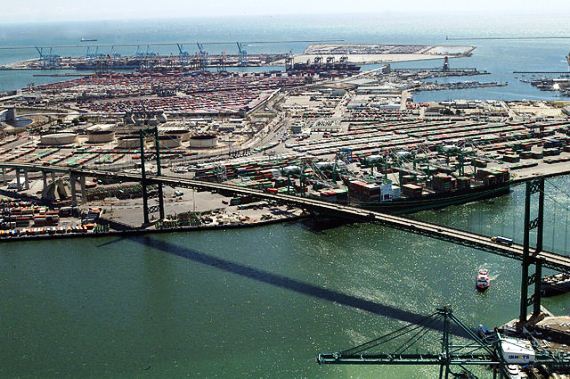-
The Port of Los Angeles, Port of Shanghai, and C40 Cities will work with industry partners to reduce greenhouse gas emissions on the transpacific corridor
-
The partnership commits to deliver an implementation plan for the green corridor by the end of 2022
-
The group aims to reduce greenhouse gas emissions from ships throughout the 2020s and transition to zero-carbon fuelled ships by 2030
-
Partners include A.P. Moller-Maersk, CMA CGM, Shanghai International Ports Group, and COSCO Shipping Lines
The ports of Los Angeles and Shanghai and a group of mayors have announced a partnership to create a first-of-its-kind green shipping corridor on one of the world’s busiest container shipping routes.
The Port of Los Angeles, Port of Shanghai, and the C40 Cities—a network of mayors worldwide working to confront the climate crisis—convened the partnership with leading industry partners to create the world’s first transpacific green shipping corridor between ports in the United States and China.
The group aims to reduce greenhouse gas emissions from the movement of cargo on the transpacific trade lane throughout the 2020s, and to transition to zero-carbon fuelled ships by 2030.
Convened by C40 Cities and the ports of Shanghai and Los Angeles, and including key maritime stakeholders, this partnership has agreed to work on an initiative to establish a Green Shipping Corridor to decarbonize goods movement between the largest ports in the United States and China.
The partnership intends to achieve these goals by developing a “Green Shipping Corridor Implementation Plan” by the end of 2022 that will provide an outline for how they will continue to decarbonize this key maritime shipping corridor.
The City of Shanghai, the City of Los Angeles, the Port of Shanghai, the Port of Los Angeles and C40 Cities initiated this Green Shipping Corridor partnership, according to a joint release on January 28.
Participating partners include A.P. Moller-Maersk, CMA CGM, Shanghai International Ports Group, COSCO Shipping Lines, the Aspen Institute’s Shipping Decarbonisation Initiative, facilitators of Cargo Owners for Zero Emission Vessels, and the Maritime Technology Cooperation Centre-Asia.
Key decarbonization goals for the Green Shipping Corridor partnership include the phasing in of low, ultra-low, and zero-carbon fueled ships through the 2020s, with the world’s first zero-carbon transpacific container ships introduced by 2030.
Other objectives are to develop best management practices to help reduce emissions and improve efficiency for all ships using this international trade corridor, and reduce supply chain emissions from port operations to improve air quality in the ports of Shanghai and Los Angeles and adjacent communities.
Mayor of Los Angeles Eric Garcetti has been instrumental in developing the Los Angeles-Shanghai Green Shipping Corridor partnership.
Gene Seroka, executive director of the Port of Los Angeles, highlighted the importance of international collaboration in decarbonizing global supply chains.
“We look forward to partnering with the Shanghai Municipal Transportation Commission, the Shanghai International Port Group, leading shipping lines and major cargo owners to reduce greenhouse gas emissions in the maritime supply chain. It’s time to get started on this important work,” he said.
Mark Watts, executive director of C40 Cities, added, “Accelerating efforts to decarbonize the shipping sector is urgent if we are to limit global heating to 1.5°C…. we hope this ground-breaking green shipping corridor initiative will catalyze action on a global scale.”
Dan Porterfield, president and CEO of the Aspen Institute, said the institute will help deploy the first vessels powered by zero life-cycle greenhouse gas emission fuels along this critical shipping route, and make the project a model of success for the rest of the world.
“It is inspiring that the United States and China have come together in this way to address the climate impact of this crucial global industry,” he said.
Photo by United States Coast Guard





